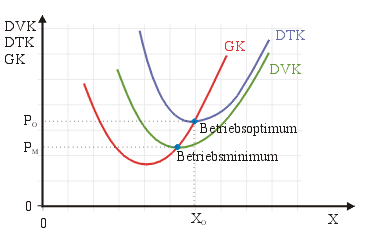Short-term lower price limit
In microeconomics and accounting, the short-term lower price limit or also the absolute lower price limit denotes the minimum price of the average variable costs (variable unit costs ). The associated unit of measure is called the operating minimum. In the short term, there is no need to cover fixed costs , provided there are no effects on the pricing policy . The KPUG is one of three lower price limits . In addition to this, there is the long-term lower price limit , which accordingly describes the average costs including fixed costs, and the liquidity-oriented lower price limit.
Sometimes the short period is given for a period of less than a year, but such periods of time are more likely to be decided on a company-by-company basis according to the company 's goals. The time frame for the lower price limits is more based on the cost situation and technical capacity utilization and, depending on the market, on the economic market situation.
Explanation
This price limit is reached when the unit price or market price just covers the variable costs per unit (average variable costs).
If a company produces at the operating minimum and then sells at the price of the short-term lower price limit, the company makes a calculated loss in the amount of the fixed costs. At the same time, full coverage of the variable costs is achieved . If the company sells at a lower price than the short-term lower limit, a negative contribution margin is achieved and production should be stopped. In the event of fluctuating market prices for the goods produced, a company can temporarily reduce the price to this price limit in order not to be forced out of the market by the competition or to drive one or more competitors off the market. The fixed costs are not covered, the associated loss can be accepted - for a short time.
In terms of calculation, one could also say that the short-term lower price limit results from the addition of direct material costs ( MEK) and variable production costs (FEK).
Short-term cost and success-oriented lower price limit
The lower price limit described so far is sometimes also called the cost-oriented lower price limit , namely when a company only manufactures one product.
In the case of multiple products, the fixed costs could be covered by the sum of all contribution margins, so that full cost coverage can be dispensed with for individual products. One also speaks of a success-oriented lower price limit . If there are bottlenecks in the company, the costs that arise when the production of another product is stopped ( opportunity costs ) must be added to the variable costs.
Determination of the lower price limits
Directly via variable average costs
The short-term lower price limit is calculated by setting the first derivative of the variable unit cost function equal to zero and inserting the value obtained afterwards into the variable unit cost function.
example
Be it .
Quantity 5 describes the operating minimum. The price that results from the variable average cost function for this quantity is the short-term lower price limit:
- .
Indirectly via the marginal cost intersection
The same result is obtained if the intersection of the marginal cost curve (also:) and the variable unit cost curve (also:) is calculated by equating both functions and then using the value obtained afterwards in the variable unit cost function .
The intersection of the red curve (marginal costs) and the green curve (average variable costs) in the market diagram consists of the operating minimum (quantity) and the short-term lower price limit (price).
example
Be it .
After this calculation, the solution is obviously again.
Individual evidence
- ↑ Lower price limit - definition in the Gabler Wirtschaftslexikon.
- ^ Heinz J. Aubeck: Business Mathematics for School and Training. BoD – Books on Demand, 2009. p. 225.
- ↑ Manfred Weber: Commercial arithmetic from A – Z: formulas, calculation examples, tips for practice. Haufe-Lexware, 2010. p. 87.
- ↑ Jörg Wöltje: quick introduction to accounting. Haufe-Lexware, 2008. p. 316.
- ↑ a b Patrick Bilo: Establishment of cost centers to improve the operational accounting and calculation of a medium-sized heating manufacturer. diploma. de, 2003. p. 43. ( online )
- ^ Frank Kalenberg: Cost accounting: Basics and applications. With exercises and solutions. Oldenbourg Verlag, 2008. p. 271.
literature
- Carl-Christian Freidank: Cost accounting: Introduction to the conceptual, theoretical, accounting and planning and control-oriented fundamentals of internal accounting as well as an overview of cost management concepts. Walter de Gruyter, Munich 2012, ISBN 978-3-486-71769-3 , p. 318 ff.









